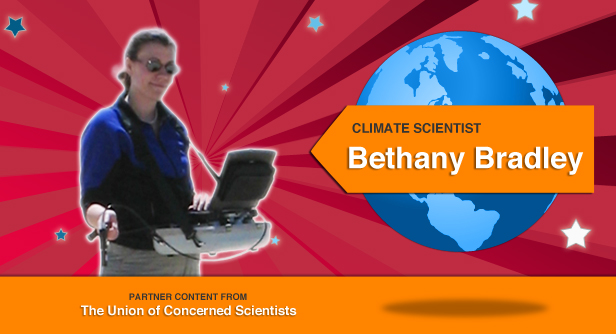When Bethany Bradley describes her research as probing the link between global warming and “alien invaders,” as she did in a recent journal article, the reader may be understandably disconcerted, especially since Bradley’s early graduate work involved mapping the surface of Mars. But rest assured: The alien invaders she studies today as a climate scientist and biogeographer at the University of Massachusetts, Amherst, are nonnative plant species such as kudzu (Pueraria lobata), endemic through the southern U.S., and purple loosestrife (Lythrum salicaria), which now clogs many of the nation’s waterways and canals.
While invasive plants are surely not as unsettling as the arrival of invaders from outer space, many such species have disrupted vast tracts of rangelands as well as farms and critical natural habitats. Bradley examines how global warming threatens to accelerate the spread of invasive plants, addressing a largely ignored risk and offering specific projections that can help ranchers, farmers, and conservation biologists anticipate what to expect.

As Bradley explains, “Invasive plant species are well suited to thriving in novel environments because of their ability to beat out competitors for resources. So it stands to reason that the more we disrupt the climate, the more these plants might be able to expand their reach.”
Bradley cautions, however, that invasive plant species are a diverse lot; accurately predicting how they will adapt to a warming climate means understanding a lot of complex interactions. Take, for instance, her recent work on cheatgrass (Bromus tectorum), a widespread scourge in North America’s Great Basin, bounded on the east by the Rocky Mountains and on the west by the Sierra Nevada range. Cheatgrass, Bradley says, was the species that drew her to study invasive plants in the first place. Early in her career as a graduate student in planetary geology at Brown University, Bradley recalls, one of her advisors gave her work on a project incorporating “remote sensing” satellite data of the earth. It seemed to her that she was seeing biology writ large. “I took to it immediately,” she says. “I had always been interested in biology but found it so much more fascinating on this kind of broad landscape scale.” Plus, compared with her studies of Mars, “it felt good to work on something closer to home that could be more directly useful to people.”
Cheatgrass was probably introduced into North America as seed contaminants in hay imported from Europe in the late 1800s. Farmers gave it that name because it pushes out wheat crops. In early spring, it looks like wheat but soon turns dry and tough, thereby “cheating” farmers of their expected yields. Worse yet, Bradley says, cheatgrass is 10 times more prone to fire than the sagebrush and grass habitat it most often displaces, and the resulting wildfires leave a burnt-out, barren landscape that facilitates the species’ further expansion.
Bradley says that cheatgrass, more than some kinds of vegetation, stands out particularly clearly in satellite data, “with a strong and distinctive green signal.” When she first observed it, she had no idea what it was, but the vast swath of land in the Great Basin that it covered was unmistakable. As she recalls, “Having grown up on the East Coast [in Connecticut], I was awed by the scale of the territory cheatgrass covered; I soon learned that it had come to dominate some 40,000 square kilometers (15,444 square miles) in this region — an expanse 10 times larger than Rhode Island, where I was in graduate school at the time.”
A decade ago, when she began graduate school, Bradley says, the field of climate change was not nearly as well established as it is today, and the effects of human-driven carbon emissions were less fully understood. Nonetheless, she was drawn to learning more about how urbanization and other human disruptions of the environment have helped foster the spread of invasive plant species. She adds that her current research into the effects of human-caused disruption of the climate is a natural extension of this earlier work.
“Climate change threatens to profoundly alter entire global ecosystems,” Bradley says. “Invasive species have been exciting to study as a window into such potential changes. Ideally, this kind of work can help us more realistically assess the risks and opportunities we face.”
To this end, Bradley uses a technique called “bioclimatic envelope modeling,” which analyzes the climatic constraints within which a particular plant species thrives. Such an approach, she says, is well suited to studying how global warming might make a region increasingly vulnerable to invasions of nonnative species. In particular, Bradley says she tries to correlate the specific climatic factors most closely associated with a given species’ propagation. To accomplish this, Bradley first uses detailed satellite data and field observations to track the spread of an invasive species over time. Then, by comparing the species’ geographical spread to localized climate data, she teases out the climatic variables most closely associated with its successful spread. “One way of thinking about it,” Bradley says, “is that you test the changing map of the plant species’ whereabouts against every climate variable you can think of and see what factors float to the top.”
In the case of cheatgrass, Bradley determined that the variable most closely correlated with its propagation was spring rain or snow. “Precipitation later in the summer has a strong effect on cheatgrass’s competitors,” she says. “But precipitation in the spring, even more than temperature variables, correlates most closely with cheatgrass’s spread.” Presumably this spring water “gives cheatgrass its most potent advantage over competitors in quickly establishing itself.”
With that information in hand, Bradley consults each of the world’s 10 top climate models to see how much spring precipitation in a given geographical region it projects under different warming scenarios in the years to come. Then she can make detailed projections that link the projected climate conditions (resulting from our heat-trapping carbon emissions) to the geographical spread of this particular species.
Bradley has to contend with many challenges, including variations in the climate models’ projections and the confounding effects of normal year-to-year variability in weather patterns. Still, she is able to project with a good degree of confidence that cheatgrass is likely to move its range significantly northward invading new areas of Montana, Wyoming, Utah, and Colorado. Her research also indicates that significant portions of southern Nevada and southern Utah are likely to become climatically unsuitable for cheatgrass in coming decades, a finding that may allow land-use managers to help restore other, more desirable native species to these regions.
As Bradley puts it, “One of the great things about this work is that, unlike other areas of climate-change research where different constituencies have legitimate competing interests, in this case, all the interested parties are on the same side: just about everyone hates invasive species like cheatgrass and would like to contain their spread. It’s an aspect that makes this research feel more like I am working to understand and maybe even help solve a problem rather than doing battle.”
This is the 15th installment of America’s Climate Scientists: A series from the Union of Concerned Scientists. Click here to read all the climate scientist profiles.
The Union of Concerned Scientists is currently leading a campaign to elevate the voices of climate scientists and educate the
public about the overwhelming scientific evidence for human-caused global warming. Learn how you can get involved at www.ucsusa.org/evidence.



